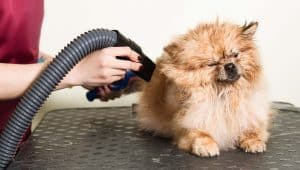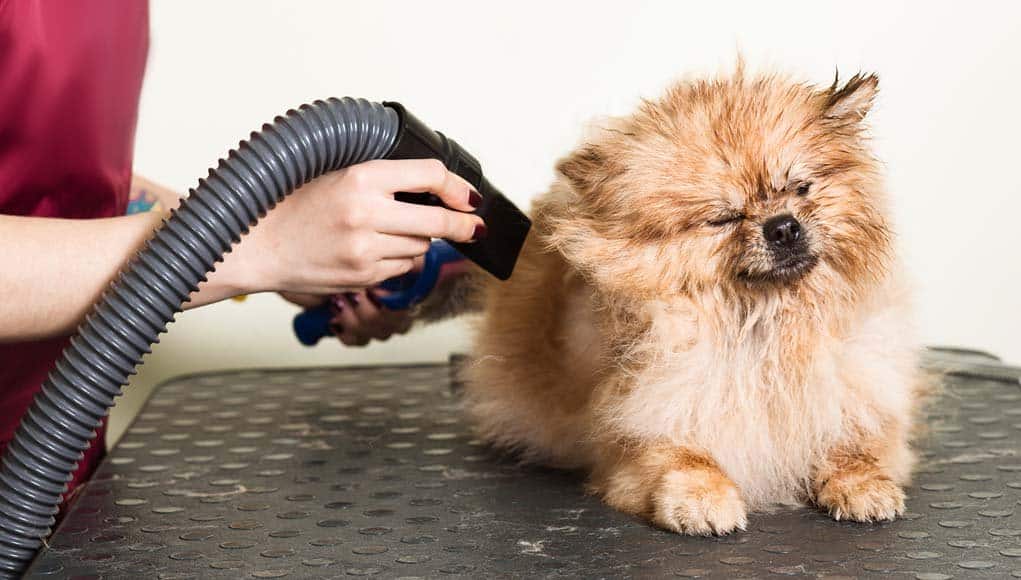Blasters are a very useful addition to the grooming environment, when it comes to drying your dog. Used correctly, they simulate the centrifugal action of the dog shaking. With the nozzle held adjacent to the coat, with the airflow aimed across the coat in two opposing directions (up and down, or side-to-side), they repel large quantities of water and any loose hairs.
In addition, the high-velocity airflow helps to remove the water by draught, saving the commercial groomer valuable time, a lot of effort and less towel laundering. Long coats can be brushed whilst you are using the blaster to help prevent knots forming.
Blasters can be very noisy, so they are not suited to all dogs, and some models are so powerful they are not suitable for use on puppies, old or disabled dogs, or those with poor muscle tone.
Some blasters have a heating element that produces warm air to help the drying process but others blow cool air only. The latter do little to dry the coat, unless used for a prolonged period, but they do disperse the majority of water from the coat. Another drying method is needed to complete the job.
You need:
- a blaster;
- a brush to suit the coat type;
- ear protectors for the groomer;
- a face-mask for the groomer; and
- possibly cotton wool for the dog’s ears.
Switch the blaster on and let the dog get used to the noise before you apply it to the coat. Start near the rear end of the dog with the nozzle at a distance from the coat. A spare pair of hands may be useful if it is the first time the dog has experienced a blaster.
When the dog is settled, turn the nozzle sideways on so that it is parallel to the coat and wave it slowly from side-to-side, either very close to the coat if the dog is short haired, or from a distance that allows the coat to blow straight if the hair is long.
If you move the nozzle too fast, it encourages long coat hairs to turn around on themselves and knotting will start. If there is a lot of water being displaced, you can hold a towel behind the area that you are working on to collect the moisture before it is expelled into the environment of your bathing room.
Work slowly and methodically over the dog, working towards the front, with the coat always being blown in the direction of hair growth. If you blow the coat in the wrong direction with the force of a powerful blaster, you risk traumatizing and bruising the skin.
 Take care not to use the blaster on sensitive areas such as the undercarriage, the throat, around the genitals and the face, and stop if the dog shows any signs of stress or discomfort.
Take care not to use the blaster on sensitive areas such as the undercarriage, the throat, around the genitals and the face, and stop if the dog shows any signs of stress or discomfort.
The advantages of blasting are that it saves on towels and drying time. The disadvantages are that it can cause bruising and skin trauma if used incorrectly and can cause damage to the bathing room environment.
Word of Caution About Blasters
Blasters are an extremely useful addition to the commercial grooming salon as long as they are used correctly. Before you use your blaster, however, you should think about what you are trying to achieve and the dog that you intend to use it on.
Blasters remove the water from the coat in the same manner as the dog shaking himself. When the dog shakes, the hairs are moved across the body in two opposing directions, so that water droplets can travel the length of the hair shafts and be thrown off at the ends.
The strong air current from the blaster causes a draught and does the same as the breeze or wind by separating the coat to remove the moisture.
You need to simulate this action with the blaster by moving the coat from side to side with the help of the air flow. Aiming the blaster directly at the dog concentrates the air flow into a small area, and the skin, rather than the coat, takes the impact. Water particles are not forced along the hair length to disperse because the air flow covers less area on the coat length.
It is worth remembering that the dog’s skin is covered by hair for a reason. As a living organ, it was not designed to be, nor should it ever be, directly exposed to an extremely high-velocity air flow aimed directly at one small point on its surface.
Using a powerful blaster incorrectly may not only dry out and bruise the skin, it can also, in some cases, cause muscle damage to the dog, so exercise caution and remember the risks when you are using one. Used correctly, they are safe and extremely useful.
Note: whip knots
Aiming the strong air current from the blaster across the coat can cause “whip knots” to form, where a long coat tangles as it blows. These are not nearly as damaging to the dog as the injuries that can be caused by the blaster being aimed directly at the skin.
On long coats, using the blaster further away from the dog helps to reduce “whip knots” by giving room for the hair to straighten out as it blows. This also allows the water particles to be blown right to the end of the hairs, from where they can disperse.

